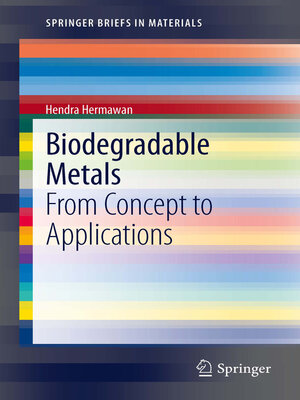Biodegradable Metals
ebook ∣ From Concept to Applications · SpringerBriefs in Materials
By Hendra Hermawan

Sign up to save your library
With an OverDrive account, you can save your favorite libraries for at-a-glance information about availability. Find out more about OverDrive accounts.
Find this title in Libby, the library reading app by OverDrive.



Search for a digital library with this title
Title found at these libraries:
| Library Name | Distance |
|---|---|
| Loading... |
This book in the emerging research field of biomaterials covers biodegradable metals for biomedical applications. The book contains two main parts where each of them consists of three chapters. The first part introduces the readers to the field of metallic biomaterials, exposes the state of the art of biodegradable metals, and reveals its application for cardiovascular implants. Some fundamental aspects to give basic understanding on metals for further review on the degradable ones is covered in chapter one. The second chapter introduces the concept of biodegradable metals, it's state of the art and discuses a shifted paradigm from inert to bioactive, from corrosion resistant to corrodible metals. The third chapter focuses on the challenges and opportunities of using biodegradable metals for cardiovascular applications. The second part exposes an example of biodegradable metals from its concept to applications where a complete study on metallic biodegradable stent is detailed from materials design, development, testing till the implant fabrication. The forth chapter reveals new alloys development devoted for metallic biodegradable stent based on required criteria derrived from clinical needs and current nondegradable stents properties. Degradation of the alloys in simulated arterial conditions and its effect to cells are exposed in chapter five. The both chapters are concluded with a benchmarking of some more recent researches on materials development and testing for biodegradable stents. Chapter six reveals the tranformation process of the materials into stent prototypes where a standard process for making 316L stainless steel stents was followed. The book is completed by a perspective on the use of biodegradable metals for biomedical applications in the era of tissue engineering.







